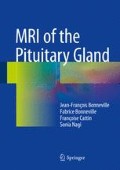Abstract
The long-acting dopamine agonist cabergoline is considered the first line therapy for both microprolactinomas and for macroprolactinomas. Tumor shrinkage starts very early (days or weeks) after initiation of medical treatment (Fig. 6.1). Therefore, cabergoline can be prescribed even for macroprolactinomas abutting the optic chiasm, but in such cases an early MR follow-up, for instance after 2 weeks, is strongly recommended to check that the optic chiasm is not further compromised. Importance of tumor shrinkage is variable and cannot be predicted in individual cases. Usually if a significant shrinkage of about 50 % is demonstrated in the first weeks after initiation of medical treatment, the maximum shrinkage of macroprolactinomas can be observed after 6 months or 1 year (Fig. 6.2). Conversely, observations of quick and complete tumoral shrinkage have been described, with a risk of rhinorrhea, meningitis, or abscess after opening a meningeal breach in macroprolactinomas invading the sphenoid sinus (Fig. 42.1). It is thus recommended to start cabergoline treatment at low dosage, and strictly assess tumoral shrinkage with MRI in those cases of macroprolactinomas invading the sphenoid sinus with skull base erosion. More frequently, shrinkage of macroprolactinoma leads to a partial or, more rarely, complete secondary empty sella with ptosis of the optic chiasm (Fig. 6.3). Tumoral shrinkage is mostly accompanied by MRI signal changes: accentuation of T2 hyperintensity of the adenoma is commonly observed (Fig. 6.4). Nevertheless, no T1 signal change is noted with hemorrhagic adenomas (Fig. 6.5) or T2 markedly hyperintense adenomas (Fig. 6.6). In these situations, tumoral shrinkage is less important than is generally seen in the more common T1 hypointense/T2 slightly hyperintense microprolactinomas.
Access this chapter
Tax calculation will be finalised at checkout
Purchases are for personal use only
Further Reading
Barber TM, Kenkre J, Garnett C et al (2011) Recurrence of hyperprolactinaemia following discontinuation of dopamine agonist therapy in patients with prolactinoma occurs commonly especially in macroprolactinoma. Clin Endocrinol (Oxf) 75(6):819–824
Bonneville F, Cattin F, Barrali E et al (2001) Increased T1 signal of the residual normal anterior pituitary gland following medical treatment of pituitary prolactinoma. J Radiol 82(4):501–505
Cuny T, Chanson P (2013) Aggressive and resistant-to-treatment pituitary tumors. Ann Endocrinol (Paris) 74:S3–S12
Author information
Authors and Affiliations
Rights and permissions
Copyright information
© 2016 Springer International Publishing Switzerland
About this chapter
Cite this chapter
Bonneville, JF. (2016). Prolactinoma and Dopamine Agonists. In: MRI of the Pituitary Gland. Springer, Cham. https://doi.org/10.1007/978-3-319-29043-0_6
Download citation
DOI: https://doi.org/10.1007/978-3-319-29043-0_6
Published:
Publisher Name: Springer, Cham
Print ISBN: 978-3-319-29041-6
Online ISBN: 978-3-319-29043-0
eBook Packages: MedicineMedicine (R0)

